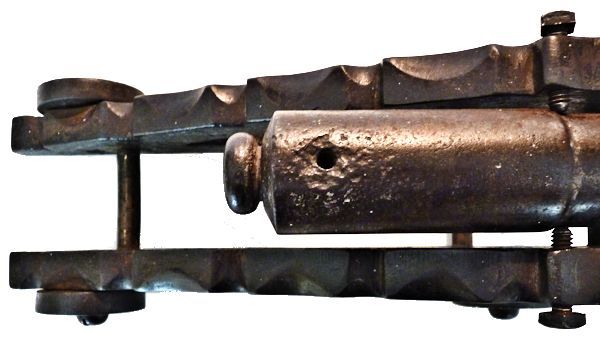Presented is
a very interestingly made, miniature, ship’s
iron cannon on a skeleton iron carriage. The skeleton carriage was introduced
by the British during the 19th Century as a means of
eliminating the deterioration of wood due to the severe elements at
sea. The barrel on this gun is decidedly American and follows the design of a Parrott field gun. Naval
versions of the 20-, 30-, 60-, and 100-pound Parrotts were also used by the Union navy. The 100-pound naval Parrott could
achieve a range of 6900 yards at an elevation of 25 degrees, or fire an 80-pound shell 7810 yards at 30 degrees elevation. This miniature
was likely made before the Civil War.
The barrel’s touch hole and bore are connected
REF.
Christie’s sold a similar 18 inch cast iron signal cannon in
its February, 2013 Sale 2677 Lot 497 for
$1750.00.
CONSTRUCTION: The two sides of the
carriage seem to be saw cut from iron 5/8 inch thick and 9
7/8 inches long
and 4 3/4 inches high at the maximum. There are no casting or
lathe marks on the barrel so it was likely cast using the “Lost Wax”
method. The trunnions at the front of the carriage fit into recesses in the
barrel and are set by ft at faced screws. Elevation of the barrel is adjusted by a square head screw at
the rear of the reinforcing band.This is a foundry made miniature using early iron working techniques. The bore is clear to
the vent hole.

The grouping of the picture above shows the
relative size of the cannon in relation to other objects and shows
how nicely it
displays.
MARKINGS:
None
DIMENSIONS:
Cannon
Length overall 16 1/8″
Length
barrel 11″
Bore 5/8″ or 63 Cal
Maximum
Width
8″
Weight
of cannon 11 pounds
Carriage 3
1/4″ W x 10″
L x 4 1/4″ H Wheels 2″ Dia



CONDITION: Neither the carriage or the
tube show any signs of rust. This is because oxidation of the iron has hardened over the years into
a midnight black patina, which is very pleasing to the eye. The
barrel has some small pitting and roughness within the bore which may
have a steel insert. This should be verified by a gunsmith. There appears
to be some small round marks around the vent hole which appear to
be the results of firing. The carriage looks to have been saw cut from
billet iron and is in the same condition. The wheels and axles are
also cast iron. The bore is open to the touch hole. There are
no mold marks or inscriptions.
This
exceedingly unique example is being sold for display purposes only. No attempt should be made to fire it
without inspection by a gunsmith.

The skeleton bronze
cannon on iron carriage dated 1840 as pictured above was made
by J.J. Wolfe, a British foundry. It was sold by us in 2007
for $7500.00.











